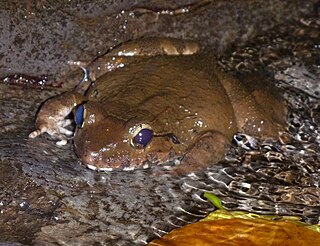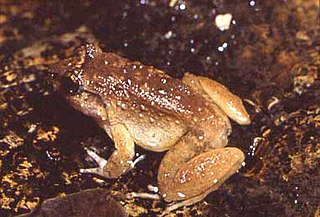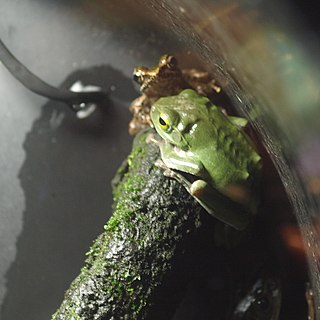Limnonectes arathooni is a species of frog in the family Dicroglossidae. It is endemic to southwestern Sulawesi, Indonesia.

Limnonectes dabanus is a species of frog in the family Dicroglossidae. It is found in Cambodia and Vietnam. Its natural habitats are tropical moist lowland forests, rivers, and swamps. Its status is insufficiently known.

Limnonectes doriae is a species of frog in the family Dicroglossidae found in the Southeast Asia.
Limnonectes fragilis is a species of frog in the family Dicroglossidae. It is endemic to the Hainan Island, China. It is a medium-sized frog, males being 49 mm (1.9 in) and females 52 mm (2.0 in) snout-vent length. Its natural habitats are subtropical or tropical moist lowland forest and rivers. It is threatened by habitat loss.

Limnonectes fujianensis is a species of frog in the family Dicroglossidae. It is most closely related to, and formerly confused with Limnonectes kuhlii. Its name refers to the type locality in Fujian province of China. It is also found in Hunan, Zhejiang, and Jiangxi in China as well as in Taiwan. and other sources give a somewhat broader distribution.

Limnonectes gyldenstolpei is a species of frog in the family Dicroglossidae. It is found in northern Thailand, Laos, and southwestern Cambodia.

Limnonectes ingeri is a species of frog in the family Dicroglossidae. It is found in Borneo . Its natural habitats are tropical moist lowland forests, rivers, and swamps. It is probably seriously affected by habitat loss, and locally also by collection for food.

Limnonectes kadarsani is a species of frog in the family Dicroglossidae. It is endemic to Indonesia where it is found in the Lesser Sunda Islands. Specifically, it has been recorded from Lombok, Sumbawa, Flores, and Adonara. Its natural habitats are tropical primary and secondary wet and dry forests where it occurs around forested streams. It is a relatively common frog. It is not considered threatened by the IUCN although potential threats include exploitation for food, water pollution from agriculture, and forest clearing.

The Koh Chang frog or Koh Chang wart frog is a species of frog in the family Dicroglossidae. It is found in east Thailand and southern Cambodia. Records from Laos and Vietnam represent other species.

The fanged river frog, Javan giant frog, Malaya wart frog, or stone creek frog is a species of frog in the family Dicroglossidae endemic to Sumatra and Java, Indonesia. Records from other regions are probably caused by misidentifying other species such as Limnonectes blythii as this species.

The giant Philippine frog, large swamp frog, or Mindanao fanged frog is a species of frog in the family Dicroglossidae. It is endemic to the Philippines. Its natural habitats are tropical moist lowland forests, subtropical or tropical moist montane forests, rivers, intermittent rivers, freshwater marshes, and intermittent freshwater marshes. It is becoming rare due to habitat loss.
Limnonectes nitidus is a species of frog in the family Dicroglossidae. It is endemic to Peninsular Malaysia where it is only known from the Cameron Highlands and Fraser's Hill, both in Pahang state.

Limnonectes palavanensis is a species of frog in the family Dicroglossidae. It is found in the Palawan Island and in Borneo. The species shows paternal care, a relatively rare trait in frogs.

Limnonectes paramacrodon is a species of frog in the family Dicroglossidae. It is found in Malay Peninsula, Borneo, and Natuna Besar. Its natural habitats are lowland swamp forest areas with small rivers and streams. It is becoming rare due to habitat loss.
Limnonectes plicatellus is a species of frog in the family Dicroglossidae. It is found on the Malay Peninsula in Malaysia, Singapore, and southern Peninsular Thailand. Its natural habitats are small streams; it is associated with swampy puddles in primary and degraded rainforest. It is not considered threatened by the IUCN.
Limnonectes shompenorum is a species of frog in the family Dicroglossidae. It is found in Great Nicobar Island (India), its type locality, and in western Sumatra (Indonesia). It is similar to Limnonectes macrodon. The name refers to Shompen people, the indigenous people of the interior of Great Nicobar Island.
Limnonectes tweediei is a species of frogs in the family Dicroglossidae. It is found in Sumatra (Indonesia) and the Malay Peninsula (Malaysia).

Zhangixalus viridis is a species of frog in the family Rhacophoridae. It is endemic to Ryukyu Islands, Japan, and known from Okinawa, Iheya and Kume Islands of the Okinawa Group. Zhangixalus amamiensis from the Amami Group was formerly included in this species as a subspecies.
Rana ulma is a species of frog in the family Ranidae. It is endemic to Okinawa Islands, in the central Ryukyu Islands of Japan. It is currently only known from northern Okinawa Island and from Kume Island. Common names Okinawa frog and Ryukyu brown frog have been used for this species; the latter can refer to this species or to Rana kobai. The specific name ulma means "coral island" in Uruma dialect of Okinawa.













